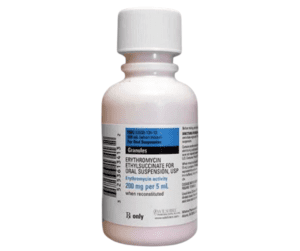E.E.S. (Erythromycin Ethylsuccinate)
E.E.S. (Erythromycin Ethylsuccinate)
E.E.S. (Erythromycin Ethylsuccinate) is commonly prescribed to treat a wide range of bacterial infections. It works by stopping the growth of bacteria, making it effective against respiratory tract infections, skin infections, ear infections, and certain sexually transmitted diseases. This medication is often used as an alternative for patients allergic to penicillin.
Why Choose E.E.S. (Erythromycin Ethylsuccinate)?
- Treats bacterial infections such as respiratory, skin, and ear infections
- Suitable alternative for patients with penicillin allergies
- Available in oral suspension and tablet form for flexible use
- Helps relieve infection-related symptoms like sore throat, fever, and discomfort
- Trusted by healthcare professionals for decades of safe use
How to Use E.E.S. (Erythromycin Ethylsuccinate)?
- Take exactly as prescribed by your healthcare provider
- Shake the oral suspension well before each use (if applicable)
- Take with or without food; if stomach upset occurs, take with a meal
- Complete the full course even if you start feeling better
- Store at room temperature away from excess heat and moisture
- Do not skip doses or stop early without medical advice
Important Safety Information about E.E.S.
- Use only for bacterial infections; not effective against viral infections (e.g., colds, flu)
- Inform your doctor if you have liver disease, heart rhythm disorders, or a history of jaundice
- Tell your healthcare provider about all medications you are taking to avoid interactions
- Avoid alcohol and grapefruit products during treatment, as they may interfere with effectiveness
- Pregnant or breastfeeding women should consult a doctor before use
Fact Table
| Facts | Details |
| Generic Name | Erythromycin Ethylsuccinate |
| Brand Names | E.E.S., EryPed, Erythrocin, others (varies by region) |
| Drug Class | Macrolide antibiotic |
| Dosage Forms | Oral suspension, tablets, film-coated tablets |
| Route of Administration | Oral |
| Mechanism of Action | Inhibits bacterial protein synthesis by binding to the 50S ribosomal subunit, preventing bacterial growth |
| Typical Adult Dosage | 400 mg every 6 hours or 800 mg every 12 hours (varies by infection severity) |
| Pediatric Dosage | 30-50 mg/kg/day divided every 6-8 hours (dosage adjusted by weight and infection type) |
| Onset of Action | Typically within 48-72 hours of starting therapy |
| Duration of Therapy | 7-14 days depending on infection |
| Contraindications | Hypersensitivity to erythromycin or other macrolides – History of cholestatic jaundice/hepatic dysfunction associated with prior erythromycin use |
| Drug Interactions | May interact with: Theophylline, Warfarin, Digoxin, Cyclosporine, Statins, Anticonvulsants, QT-prolonging agents |
| Storage | Tablets: Store at room temperature, away from heat and moisture – Oral suspension: Refrigeration recommended for stability; discard after 10–14 days |
| Common Side Effects | Nausea, vomiting, diarrhea, abdominal pain, skin rash, loss of appetite |
| Precautions | Caution in patients with liver disease, heart rhythm disorders, or myasthenia gravis |
Common Side Effects
Like all medications, E.E.S. (Erythromycin Ethylsuccinate) can cause side effects, although not everybody gets them. Understanding these side effects can help you use this medication safely and effectively.
- Nausea or vomiting
- Diarrhea or stomach cramps
- Mild skin rash or itching
- Temporary loss of appetite
If you experience any side effects, discuss them with your healthcare provider. They can offer advice and may adjust your treatment if necessary. Report any severe or unexpected side effects immediately.
How Can You Buy E.E.S. (Erythromycin Ethylsuccinate)?
You can order E.E.S. (Erythromycin Ethylsuccinate) using these methods on our website:
- Order Online
- Order by Phone
- Order by Fax
- Order your refills
Visit our How to order page.




